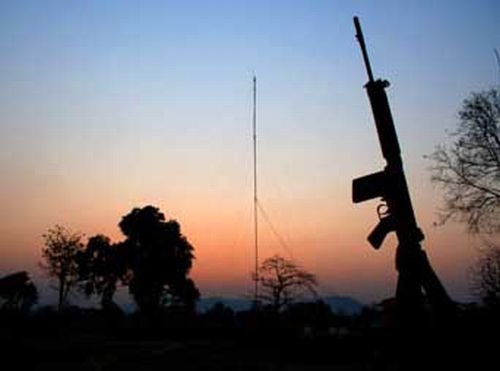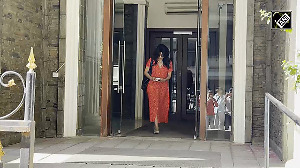 Besides weakening the Maoists' lethal capacities and reducing violence, it is essential to ensure that governance is improved, so that those prone to sympathising with, or supporting, the Maoists would, in the long run, realise the needlessness and futility of doing so, says P V Ramana and Raj Bala Rana.
Besides weakening the Maoists' lethal capacities and reducing violence, it is essential to ensure that governance is improved, so that those prone to sympathising with, or supporting, the Maoists would, in the long run, realise the needlessness and futility of doing so, says P V Ramana and Raj Bala Rana.
Displaying a sense of seriousness in dealing with Naxalites of the Communist Party of India-Maoist, or Maoists in short, the new government said it was more than 'the single biggest challenge to internal security.' According to a media report of June 2, Minister of State for Home Affairs Kiren Rijiju said, 'We want to do away with the term "Naxalism" and want it to be called "Maoism". Earlier, it was different, but now it is straightaway a threat to national security.'
The term Naxalism/Naxalites is generically used to refer to all those who subscribe to the ideology of capturing/seizing State/political power by waging a protracted people's war through the method of guerrilla warfare, on the lines propounded by Chairman Mao Zedong. The term Naxalism has its origins in the Naxalbari village, in the then Siliguri sub-division of West Bengal, where, in 1967, a tribal peasant uprising was staged by extreme left-wing rebels of the Communist Party of India-Marxist, under the leadership of Charu Mazumdar, Kanu Sanyal and Jangal Santhal.
In India, there are three streams of Naxalite groups: Those that participate in parliamentary politics and have 'postponed' their agenda of revolution; those that participate in parliamentary politics and also maintain armed, underground squads; and those that are avowedly committed to waging an armed revolution and consider parliamentary politics a sham.
The two terms, Naxalism and Maoism, are routinely used interchangeably. In this wake, it might be useful to understand the difference between the two. To state briefly, all Maoists are Naxalites, but all Naxalites are not Maoists. According to the Union ministry of home affairs, there are a total of 24 Naxalite groups in India.
On the other hand, the term Maoism/Maoists refers to cadres and leaders of the proscribed Communist Party of India-Maoist, which was founded on September 21, 2004 following the merger of the Communist Party of India-Marxist-Leninist (People's War), PW in short, (popularly known as the PWG) and the Maoist Communist Centre of India, popularly known as MCC. The CPI-Maoist belongs to the last of the three categories mentioned above.
It is the largest and most lethal of all Naxalite groups in operation in India. It is led by Muppala Lakshmana Rao, alias Ganapathy, a native of Bheerpur village in the Karimnagar district of Andhra Pradesh (now Telangana). It has a cadre strength of approximately 13,000 men and women.
The guerrillas have an impressive arsenal. They have come a long way from fielding traditional farm implements such as crowbars, sickles and spears to fielding a melange of weapons, including country made weapons, single barrel breach guns, double barrel breach guns, light machine guns, self-loading rifles, AK series rifles, INSAS rifles and crude rocket launchers.
At the official level, there are no precise estimates of the total weapons-holding of the Maoists. In 2006, the annual report of the home ministry stated that the Maoists have 6,500 weapons of various makes.
Besides, the Maoist arsenal is largely indigenous and, indeed, ingenious; outright purchase of arms in the grey arms market is only in 'fits and bouts'. Their ingenuity in the manufacture of weapons is noteworthy. For example, there have been instances when the Maoists uprooted telephone poles, cut them into two pieces, filled them with explosive material and used them as cannons.
The rebels maintain production units in all areas of their operations, and a dedicated team undertakes the repair and fabrication of weapons.
With an array of weapons at their disposal, the rebels have executed several chilling massacres in various parts of the country, killing innocent civilians, political leaders and security personnel. For instance, on April 6, 2010, the rebels killed 76 personnel of the Central Reserve Police Force at Tadmetla, near Chintalnar village, Chhattisgarh.
In the same state, in the Darbha Ghati area, the Maoists, on May 25, 2013, killed in cold blood 27 people, including the top-leadership of the Chhattisgarh unit of the Congress party.
In the wake of the rising tide of Maoist violence, over the past few years the Union government had expressed its firm resolve to take the rebels head on, and initiated various security and development measures. This resolve has been reiterated, once again, if only a little more strongly, by the new minister of state for home affairs when he said 'it is straightaway a threat to national security.'
If coordinated action is taken by the Union government and all the affected states the Maoist challenge could be certainly defeated. A welcome development is that the various state governments have begun to evince willingness to deal with the issue.
The Union government needs to urgently build a consensus among the affected states on the approach to deal with the rebels and provide the necessary leadership. Further, capacities of state police forces need to be built up, among other things.
Besides weakening the Maoists' lethal capacities and reducing violence, it is also essential to ensure that governance is improved; development schemes and programmes are implemented effectively; and their implementation is monitored rigorously, so that those prone to sympathising with, or supporting, the Maoists would, in the long run, realise the needlessness and futility of doing so.
P V Ramana and Raj Bala Rana are with the Internal Security Centre, Institute for Defence Studies and Analyses, New Delhi.










